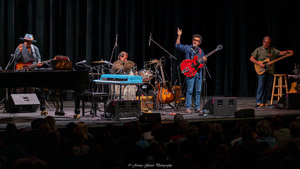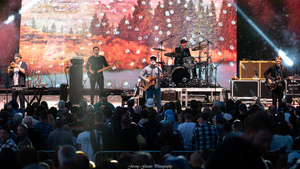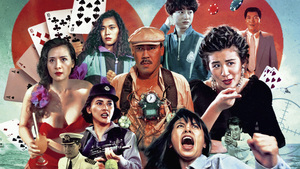
Alonso Ruizpalacios
by Generoso Fierro
Having greatly admired Alonso Ruizpalacios’ work since viewing his auspicious debut from 2014, Güeros, I knew that the day was forthcoming when the native Mexico City director would have to take on a more visceral approach to confront the unethical elements of his society that plagued the main characters of his first two feature films: the aforementioned Güeros and his highly-acclaimed follow-up, Museo.
A Cop Movie, Ruizpalacios’ third feature, which was nominated for Best Film at the Berlinale where it won the Silver Bear for Outstanding Artistic Contribution, sees the director not only abandoning temporal settings decades in the past—Güeros and Museo examine the institutionalized dysfunctions of previous eras in the ’90s and ’80s respectively—but also sees him incorporating a daring hybrid cinema approach that creates empathy for his characters, while he closely investigates the human costs of police corruption that is omnipresent in and around Mexico City.
As our film opens, we witness Teresa, a lone police officer who is patrolling her sector of Mexico City, being called to respond to an apartment where a woman is giving birth. Teresa arrives on-scene, but without an ambulance in sight, she wades through the bystanders amassed in front, and is questioned by them as to the absence of emergency personnel who had been called some time before. As Teresa is a veteran officer, she sadly knows full well that EMTs, who are in short supply and in high demand in Mexico City, will most likely not be arriving anytime soon. Still, she pleads with her dispatcher to send an ambulance, but receives no helpful reply, so she is forced to deliver the baby herself, a feat that Teresa executes bravely with her only pair of rubber gloves to grab the baby and children’s scissors that the expectant mother’s husband has on premise to cut the umbilical cord. It is a miraculous moment of valor, and when the mother’s state raises concern after the birth, Teresa has no choice but to call in a favor with her life partner, Montoya, a fellow officer, who normally has better luck in getting the dispatcher to do her sworn duty.
Through filmed recreations of Montoya’s and Teresa’s exploits on duty, which Ruizpalacios adeptly combines with direct to camera interviews with the pair, we gain knowledge of this couple, who, despite taking different paths that led them to their careers in enforcement, are still confronted with similar negative outcomes from their time on the job. We see these officers struggle in their interactions with a public who refuse to view them as anything but corrupt, even though it is made clear through Teresa’s and Montoya’s own testimony that it was never their intention to be complicit with the graft that is the hallmark of their department. Their fellow officers also provide no relief to their feelings of persecution either, as Teresa and Montoya must begrudgingly pay cash to them for the use of the very gear that is essential for them to do their jobs.
As A Cop Movie progresses with its erratic construction that purposefully keeps the viewer off balance, we become immersed into Teresa’s and Montoya’s turbulent world, and thus, we develop a great deal of sympathy for their situation. This is the case until the halfway point of the film, when Ruizpalacios makes an abrupt shift in the structure through the use of a surprising reveal—a reveal that makes us question the reality of what we have seen until that point, and potentially opens up preconceived notions that we may have about law enforcement in Mexico.
I was thrilled to have an in-depth conversation with Ruizpalacios about his new feature. We discussed his original motivations for making A Cop Movie, as well as his decision to incorporate a hybrid documentary approach and his unique methods for preparing his actors for their challenging roles.
Q: I see a parallel between your previous feature, Museo, and A Cop Movie in that both films delve into the normalization of motivations and behavior that clash with society’s expectations and morality. In Museo, Benjamin and Juan are middle class, whereas Teresa and Montoya come from working poor families. After you made Museo, was it important for you to examine this societal issue from a different socioeconomic perspective with your next project?
A: Yes, it is a very interesting link, the one that you’re making here, Generoso, and I think that it’s probably there, but in a very subconscious way. I will say that the motivations for this project came from a different place, but then, of course, it ends up happening that once you’re doing something or even when you are finished doing something, you realize what was really behind your motivations. Also, I should say that at some point during filming, I realized that I am making another road movie in Mexico City (laughs). You know during this one moment, when we were shooting that patrol car around town, I thought to myself, “Shit, am I really doing this again? Why, why am I shooting people in cars in Mexico City!?” (laughs)
But for me, the starting point was to do something to address a kind of false hope of feeling useful somehow, as I don’t believe that cinema is useful at all, but that is also why I like it. I think that it gives us the illusion of somehow being able to do something that will be a useful tool, and so I did have that urge of wanting to create something useful at the end of the Peña Nieto period.
Peña Nieto, the former President, towards the end of his term was operating at an all-time high of impunity and corruption, so I wanted to make a movie that addressed that, and I got together with Elena [Fortes] and Daniela [Alatorre], my producers, to start thinking about some way to comment on this situation. So, it didn’t all start off as specifically being about the police force or about someone being in a lower sphere of the social ladder, but that kind of came together organically as we all began exploring the subject matter.
Q: I do feel that through the story of Teresa and Montoya in A Cop Movie, you do exemplify the absurdity of the corruption of the Peña Nieto period. I also believe that, although A Cop Movie exhibits you taking a different kind of approach than the ones you took with Güeros and Museo, you still have as central characters people who want to exact some kind of change in their lives, but who are all stymied because of the reality of a corrupt or unethical system in front of them. With Güeros, which is set in the late ’90s, and Museo which is set in the mid-80s, we have a chance to look back and judge in hindsight the negative effects of the venality of the past, but with A Cop Movie being contemporary, how do you view the corruption of the past eras that you explored with Güeros and Museo in terms of how they led to the institutionalized corruption that is present with the police in Mexico today?
A: That is an interesting question. For me, it is very sad to realize that corruption is still so pervasive and that it rules over Mexico. It is one of the biggest cancers in Mexico, and it is one of the main sources of all that is going wrong with our country, particularly, I mean, corruption combined with impunity. So, frustratingly, it has not been solved. That is the big wager with the current government in Mexico; they came in saying that they were going to fight corruption and that it is their main agenda. We’ll see what happens and if they have any success, but I don’t think that it has been fixed.
We discussed this issue a lot when we were developing this movie. This movie had a long period of gestation when we spoke with academics, very smart people who specialize in public order and public policy as well. We had some key advisors who accompanied us through the whole process of making the film. Even during the editing period, I was still having conversations with these advisors, three key people who work in police reform and public policy who assisted us along the way.
I remember one of these early conversations, we even went as far as discussing the foundations of Mexico. I remember asking an advisor, “Why is corruption so pervasive in Mexico, and why is it so much a part of our psyche?” His reply was very interesting. He said, “When Mexico was a Spanish colony, and the laws were dictated from Spain, the laws were made in Spain for how España, the colony of New Spain, was going to govern themselves. It was made by people who were not physically there—they were thousands of miles away. So, the legislators in New Spain had this saying between them: ‘We abide by the law, but we do not obey it.’” That was a common saying. And so, Ernesto López Portillo, who shared this with us, was serious when he said that this attitude comes from the foundation of Mexico. There is this huge distance between the law and what is achievable in reality. And I still think that is kind of the case. It is a very complex issue.
Q: As corruption is such an overarching dilemma in Mexico, it makes me wonder how some of the police cadets whom you interviewed for your film felt about how they could make any difference. And here, Alonso, I am particularly thinking of the one cadet in your film who stated that she joined up because of the tragic epidemic of femicide. Did any of the cadets, or the veteran officers whom you spoke with, express to you that the corruption which encumbers officers from doing their job effectively subsequently contributed to the rise of this particular crime?
A: That is a tough question, and there is most likely some relation, but the issue of femicide is again, a very complex problem. I think that a lot of the cadets whom we spoke to come in with a real desire to change things. That said, for many of them, it is frankly just a job, a way of making a living, and for others, it is a family tradition. But for a small number of the cops, it is a vocation. But in the end, you have this body of people who are undertrained, underpaid, and those factors are going to bring out all sorts of problems, but the femicide problem is beyond my comprehension and theirs. It is a tragedy, a sickness, and there are too many factors playing into it.
Q: Thinking about your process in creating A Cop Movie, I understand that you were originally approached by your producers to do a conventional documentary, but then you ultimately made the decision to utilize actors, even going as far as sending them to police academies and to patrol the streets, which ultimately created a work of hybrid cinema. What I found to be an interesting choice was that you waited until the middle of the film to show the audience that we are indeed watching actors portraying Teresa and Montoya. Can you talk about that decision?
A: The premise that we set out for ourselves was that we were going to find the form as we went along. We were not going to predetermine anything, and we were going to let the material tell us how it was going to be shot and how it was going to get shaped. And so, it was a very organic process of investigation for me, both thematically, because I was going to dive into something very foreign for me, and also formally. It was very freeing in that sense. I think that every decision was a solution for a particular problem.
Originally, we were not going to have actors portray the police officers. When we found Teresa and Montoya, our first instincts were to record them and somehow illustrate what was said, and then we thought, how are we going to illustrate all of these things that they are talking about that are very sensitive and impossible to capture on camera? All of these acts of corruption, their relationship with the public, the racism, it seemed impossible for me to capture all of that, so we are going to have to use fiction elements for this to work. Also, I have a soft spot for actors. I trained as an actor myself. I have a theater company. I am married to an actor, so the acting process has always fascinated me, and so, that is how the idea came to me, to make that a part of the movie. Why don’t we register that process, and that will be the audience’s process of getting to know the world that Teresa and Montoya are portraying.
So, finding the structure and doing that reveal in the middle of the movie was something that I wanted to give as a little shock to the audience to change lanes. There are really two stories in one: There is the story of Teresa and Montoya, and there is the story of Raúl and Mónica. There’s not one story, there are two stories, and Raúl’s and Mónica’s story is as important as Montoya’s and Teresa’s story.
Also, I thought that by that point in the movie people are going to be wondering, “What about everything that we know about the police? Where do I stand as a citizen and as a viewer with what you are showing me? I have all of these ideas about this, and they have not been addressed. The film has spent this whole time being empathetic to these characters, but what about my feeling of insecurity when I see a policeman? And what about my knowledge of corruption?” And so, I wanted to address all of this through the actors, and I thought that once we became engaged with Teresa and Montoya, it was going to be a good shift, and we were now going to address your problems with the police. I like this structure where this happens in the middle of the movie, as it switches lanes and abandons Teresa and Montoya, but then we circle back to them, and the stories reunite. And so, when you meet Teresa and Montoya after you’ve just been listening to their voices, I think that it comes as a surprise. To discover the structure along the way is a different process for me.
Q: As far as the preparation that Mónica and Raúl did for this role, did they listen to Teresa and Montoya’s dialog and then offer an emotional interpretation of what they heard, or were they directly reciting what was said to them?
A: The process was that we recorded Teresa and Montoya during interviews that took many days, and then we transcribed the interviews; we edited them; and then, we created a script, we meaning myself and a friend of mine named David Gaitán who is a playwright whom I worked with in the theater before. So, together we did the structure for what the actors were going to play, and while we were doing that, writing the script and deciding what we were going to shoot fictionally, the decision of always using the real voices was there. I knew that I never wanted to lose the voices of the real Teresa and Montoya, so then we cut the interviews into what was scripted, and we gave that to the actors, but we only gave them the sound. I didn’t want the actors to see the real Teresa and Montoya. They had no image, so they had to memorize by sound because I never wanted the actors to do an imitation of Teresa and Montoya. I wanted the actors to become them just with their voices. And so, they did the training first, and then they had two months to learn the lip sync. Raúl and Mónica worked their asses off, and they were pitch perfect.
So, they rehearsed, but they never saw the people whom they were portraying until the final day when we were shooting, and we brought Teresa and Montoya to the set where they met for the first time. We recorded that moment actually, and it was originally going to be part of the movie. But these things never turn out the way you think they will, because for me, I realized that that moment didn’t need to be seen.
A Cop Movie will be released globally through Netflix on November 5th, 2021.
https://www.netflix.com/ACopMovie
This interview has been edited for clarity and length. Photo courtesy of Netflix.












